Janome Memory Craft 2400 Instruction Manual
INSTRUCTION BOOK
 2400
2400
IMPORTANT SAFETY INSTRUCTIONS
When using an electrical appliance, basic safety precautions should always be followed, including the followings: Read all instructions before using this appliance.
DANGER—To reduce the risk of electric shock:
1.An appliance should never be left unattended when plugged in. Always unplug this sewing machine from the electric outlet immediately after using and before cleaning.
2.Always unplug before replacing a sewing machine bulb. Replace bulb with same type rated 13.2 Volts D. C. 3 Watts.
WARNING— To reduce the risk of burns, fire, electric shock, or injury to persons:
1.Do not allow to be used as a toy. Close attention is necessary when this sewing machine is used by or near children.
2.Use this appliance only for its intended use as described in this owner’s manual.
Use only attachments recommended by the manufacturer as contained in this owner’s manual.
3.Never operate this sewing machine if it has a damaged cord or plug, if it is not working properly, if it has been dropped or damaged, or dropped into water.
Return this sewing machine to the nearest authorized dealers or service center for examination, repair, electrical or mechanical adjustment.
4.Never operate the appliance with any air opening blocked. Keep ventilation openings of this sewing machine and foot controller free from accumulation of lint, dust and loose cloth.
5.Never drop or insert any object into any opening.
6.Do not use outdoors.
7.Do not operate where aerosol (spray) products are being used or where oxygen is being administered.
8.To disconnect, turn all controls to the off (“O”) position, then remove plug from outlet.
9.Do not unplug by pulling on cord. To unplug, grasp the plug, not the cord.
10.Keep fingers away from all moving parts. Special care is required around the sewing machine needle.
11.Always use the proper needle plate. The wrong plate can cause the needle to break.
12.Do not use bent needles.
13.Do not pull or push fabric while stitching. It may deflect the needle causing it to break.
14.Switch this sewing machine off (“O”) when making any adjustment in the needle area, such as threading the needle, changing the needle, threading the bobbin or changing the presser foot, and the like.
15.Always unplug this sewing machine from the electrical outlet when removing covers, lubricating, or when making any other adjustments mentioned in this owner’s manual.
SAVE THESE INSTRUCTIONS

TABLE OF CONTENTS
SECTION I NAME OF PARTS |
|
Names of Parts .......................................................... |
2 |
Extension Table (Accessory Storage Box) .................. |
3 |
SECTION II GETTING READY TO SEW |
|
Connecting Machine to Power Supply ...................... |
4 |
Controlling Sewing Speed ......................................... |
4 |
Main Function of Keys ........................................... |
5-6 |
Winding the Bobbin .............................................. |
7-8 |
• Set the Spool ....................................................... |
7 |
• Removing the Bobbin ......................................... |
7 |
• Winding the Bobbin ........................................... |
7 |
• Inserting the Bobbin ........................................... |
8 |
Threading the machine ......................................... |
9-11 |
• Threading the machine ....................................... |
9 |
• Needle Threader ............................................... |
10 |
• Drawing Up the Bobbin Thread ....................... |
11 |
SECTION III BASIC SEWING |
|
Straight Stitching................................................ |
12-13 |
• Starting to Sew ................................................. |
12 |
• Changing Sewing Direction .............................. |
12 |
• Finishing Sewing .............................................. |
12 |
• Adjusting Stitch Length Manually .................... |
13 |
• Variable Needle Position .................................. |
13 |
Variation of Straight Stitching ................................. |
14 |
• Straight Stitch ................................................... |
14 |
• Locking Stitch .................................................. |
14 |
• Lock-A-Matic ................................................... |
14 |
• Triple Stretch Stitch ......................................... |
14 |
• Stretch Stitch .................................................... |
14 |
• Saddle Stitch ..................................................... |
14 |
Adjust the Top Thread Tension .............................. |
15 |
• Choose the Correct Tension ............................. |
15 |
• Tension is too tight........................................... |
15 |
• Tension is too loose .......................................... |
15 |
• Seam Allowance Lines....................................... |
16 |
When Sewing Heavy Fabrics ................................... |
16 |
Pressure Adjusting Lever .......................................... |
16 |
To Raise or Drop the Feed Dog .............................. |
16 |
Changing Needles ................................................... |
17 |
To Remove and Attach Presser Foot ........................ |
17 |
To Remove and Attach the Foot Holder ................. |
17 |
Choose Your Needle and Thread ............................ |
18 |
Zigzag Stitch ........................................................... |
19 |
• Manual Stitch Width and Length ..................... |
19 |
SECTION IV UTILITY STITCHING |
|
Overcasting ............................................................. |
20 |
• Zigzag Stitch ..................................................... |
20 |
• Overcasting Variations ...................................... |
20 |
Buttonhole ......................................................... |
21-26 |
• Buttonhole Variations....................................... |
21 |
Sensor Buttonhole .............................................. |
21-23 |
• Preparation for Sewing...................................... |
21 |
• To Sew ............................................................. |
21 |
• To Alter Buttonhole Stitch Width and Density ........ |
23 |
• Rounded and Keyhole Buttonholes .................. |
24 |
Automatic Buttonhole (BH 1 )........................... |
25 |
Corded Buttonhole .................................................. |
26 |
Sew a Button ........................................................... |
27 |
Zipper Sewing .................................................... |
28-29 |
• To Snap On the Zipper Foot ............................ |
28 |
• Fabric Preparation ............................................ |
28 |
• To Sew ............................................................. |
28 |
Blind Stitch Hemming ............................................ |
30 |
• Changing Needle Position ............................... |
30 |
Rolled Hem ............................................................. |
31 |
SECTION V DECORATIVE STITCHING |
|
Shell Stitch .............................................................. |
32 |
Patchwork ............................................................... |
32 |
Smocking ................................................................ |
32 |
Decorative Stitch ..................................................... |
33 |
Scallop Hems .......................................................... |
33 |
Cording ................................................................... |
34 |
Quilting .................................................................. |
35 |
Adjusting Pattern Balance ....................................... |
36 |
Program Decorative Stitch Patterns ......................... |
37 |
• Combining Patterns .......................................... |
37 |
SECTION VI CARE OF YOUR MACHINE |
|
Care of Your Machine ............................................. |
38 |
Cleaning the Hook Race and Feed Dog .................. |
38 |
Replacing the Bobbin Holder .................................. |
38 |
Troubleshooting ...................................................... |
39 |
1
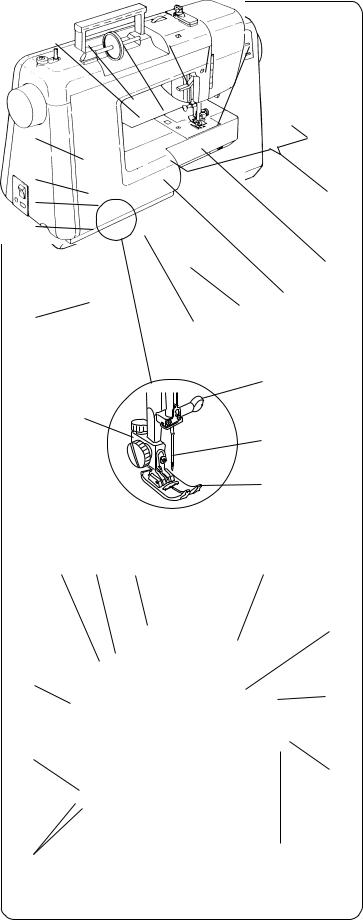
y u i o !0 !1
t
r
e !2 w
!3
!4
q |
!5 |
|
!6 |
||
|
!9
!7
@0
!8
@4 @5 @6 |
@7 |
@8
@3
@9
@2
#0
@1 |
#1 |
|
SECTION I NAME OF PARTS
Names of Parts
q Extension table (Accessory box) w Needle plate
e Needle threader r Thread cutter t Face plate
y Thread take-up lever u Upper thread guide i Thread tension dial o Spool pin
!0Spool holder
!1Liquid crystal display
!2Function keys
!3Screen sharpness adjusting knob
!4Reverse button
!5Feed balancing dial
!6Hook cover plate release button
!7Foot holder
!8Presser foot
!9Needle clamp screw
@0Needle
@1Machine sockets
@2Power switch
@3Balance wheel
@4Bobbin winder stopper
@5Bobbin winder spindle
@6Carrying handle
@7Hole for additional spool pin
@8Presser foot lifter
@9Buttonhole lever
#0Free arm
#1Drop feed lever
2
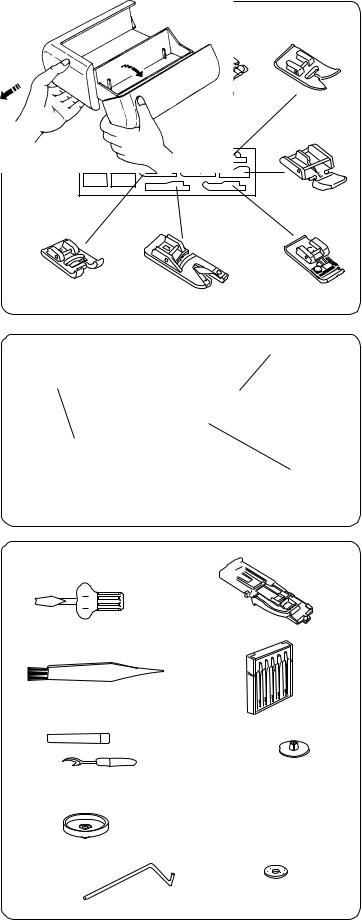
Extension Table (Accessory Storage Box)
q w e r
G |
|
A |
F |
H |
E |
|
||
D |
|
C |
q Bobbin
w G: Blind hem stitch foot e H: Cording foot
r A: Zigzag foot
tt E: Zipper foot y C: Overedge foot
u D: Hemmer foot i F: Satin stitch foot
i
z
!0
!2
!4
!7
!9
u y
o
x
 !1
!1
!3
!5 |
!6 |
|
 !8
!8
@0
o Extension Table
zPull the end of the extension table away from the machine, as illustrated.
xThe lid of the accessory storage box lifts open toward you.
Sewing accessories are conveniently located in the box.
!0Screwdriver
!1R: Automatic buttonhole foot
!2Lint brush
!3Set of needles
!4Seam ripper
!5Large spool holder
!6Small spool holder
!7Spool stand
!8Additional spool pin
!9Quilter
@0Spool pin felt
3

SECTION II GETTING READY TO SEW
|
|
Connecting Machine to Power Supply |
|
|
r |
Before connecting the power cord, make sure the voltage |
|
|
and frequency shown on the machine conform to your |
||
|
|
||
|
|
electrical power. |
|
|
|
For Use of the Foot Control: |
|
|
|
* Turn off the power switch, and insert the foot |
|
|
|
control plug q and the machine plug w into the |
|
|
|
machine and the power supply plug e into the |
|
|
|
wall, in this order. |
|
|
w |
q Foot control plug |
r Power switch |
|
w Machine plug |
t Power supply cord |
|
|
|
||
|
t |
e Power supply plug |
y Foot control |
y |
q |
For Your Safety: |
|
|
|
|
|
|
|
1. While in operation, always keep your eye on the |
|
|
|
sewing area, and do not touch any moving parts such |
|
|
|
as the thread take-up lever, handwheel or needle. |
|
|
|
2. Always turn off the power switch and unplug from the |
|
|
|
power supply: |
|
|
e |
* When leaving the machine unattended. |
|
|
* When attaching or removing parts. |
||
* When cleaning the machine.
3. Do not place anything on the foot control, except in use.
Operating Instructions:
The symbol “0”of a switch indicates the “off ” position of a switch.
For appliances with a polarized plug (one blade wider than the other ).
To reduce the risk of electric shock, this plug is intended to fit in a polarized outlet only one way. If the plug does not fit fully in the outlet, reverse the plug. If it still does not fit, contact a qualified electrician to install the proper outlet. Do not modify the plug in any way.
Foot Controller Model 21249 use with Sewing Machine Model MC 2400.
(For U.S.A. market only).
Controlling Sewing Speed
Sewing speed can be varied by the foot control.
The harder you press on the foot control, the faster the machine runs.
4

Main Function of Keys
w |
e r |
t y |
ui |
q
|
|
o |
|
|
|
q |
q Reverse Button |
|
|
|
|
During straight stitching |
, zigzag stitching |
and multiple zigzag stitching |
, |
||
|
|||||
|
press and hold the reverse button. The machine will sew in reverse until you release |
||||
|
the button. |
|
|
|
|
|
During utility stitching and decorative stitching, press this button and the machine |
||||
|
will sew an auto-lock stitch and stop automatically. |
|
|||
w |
w Auto-Lock Key |
|
|
|
|
During straight stitching |
, zigzag stitching |
and multiple zigzag stitching |
: |
||
|
|||||
The machine will take a few stitches in place and stop automatically. During utility stitching and decorative stitching:
Press this key when running the machine to sew an auto-lock stitch at the end of pattern and stop automatically.
e |
e Up/Down Needle Position Key |
|
When you press this key, the needle will go up or down. |
||
|
||
|
If the needle is up and you press this key, the needle will go down to its lowest |
|
|
position. |
|
|
If the needle is down and you press this key, the needle will go to its highest position. |
|
r |
r Screen Sharpness Adjusting Dial |
|
Sharpness of liquid crystal will change. |
||
|
||
|
* Turn the screen sharpness adjusting dial if LCD screen is not clear (or completely |
|
|
dark), when turning on the power switch. |
t |
t Stitch Width Control Key |
|
Stitch width and stitch length will show on the liquid crystal display. |
||
|
||
|
* To decrease the stitch width, press the “ ” key . |
|
|
The stitch width will decrease. |
*To increase the stitch width, press the “ + ” key . The stitch width will increase.
5
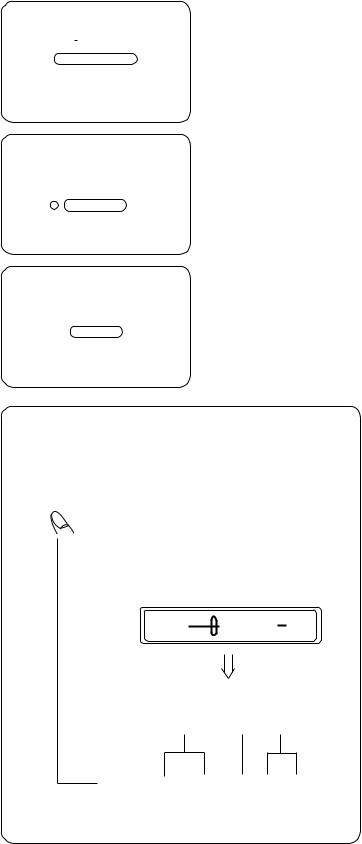
y |
|
|
y Stitch Length Control Key |
|||||||||
|
|
Stitch width and stitch length will show on the display. |
||||||||||
|
|
|
|
|
|
|
|
|
|
|
|
|
|
|
|
|
|
|
|
|
|
|
|
|
To decrease the stitch length, press the “–” key. |
|
|
|
|
|
|
|
|
|
|
|
|
|
|
|
|
|
|
|
|
|
|
|
|
|
The stitch length will decrease. To increase the stitch length, press the “+” key. |
|
|
|
|
|
|
|
|
|
|
|
|
|
|
|
|
|
|
|
|
|
|
|
|
|
The stitch length will increase. |
|
|
|
|
|
|
|
|
|
|
|
|
|
u
M
uMemory Key
When this key is pressed after selecting a pattern, the pattern will be memorized as many times as the key is pressed. When the key is pressed after selecting another pattern, that pattern will be memorized after the previously memorized pattern.
(Up to 50 patterns, including the locking stitch at the end, can be programmed in the memory.)
i
C
o
iClear Key
When this key is pressed before starting sewing, the memorized characters can be cleared one by one.
When the key is pressed after starting sewing, the entire memorized program is cleared.
oPattern Selection Keys
You can select these patterns by pressing the pattern selection keys.
1 01 |
A 2 6 |
3 4 5
2
1.Display when the power switch is turned on and Pattern 01 is selected.
2.Display when a pattern is selected, (Example: Pattern 19.)
3.Pattern number and pattern
4.Recommended Foot
5.Suitable thread tension
6

w q t
er
q
w
z x
t
c |
y |
|
v b
Winding the Bobbin
• Set the Spool
Lift up the spool pin and place the spool of thread on it with the thread coming off the spool as shown.
Press the large spool holder firmly against the spool of thread.
*The small spool holder is used with small or narrow spools of thread.
q |
Spool pin |
r |
Small spool holder |
w |
Ordinary spool |
t |
Small spool |
eLarge spool holder
•Removing the Bobbin
Gently slide the hook cover plate release button to the right and remove the cover plate.
Lift out the bobbin.
q Hook cover plate release button
wHook cover plate
•Winding the Bobbin
z Guide the thread around the thread guide.
xThread through the hole in the bobbin from the inside to the outside.
*The additional spool pin is used to wind an extra bobbin without unthreading the machine. To use, insert the spool stand and the additional spool pin in the hole. Place the felt and spool on the pin with the thread coming off the spool as shown.
q Hole for additional spool pin |
r Felt |
w Spool stand |
t Spool |
e Additional spool pin |
|
cPut the bobbin on the bobbin winder spindle and push it to the right. With the free end of the thread held in your hand, depress the foot control. Stop the machine when it has made a few turns, and cut the thread close to the hole in the bobbin.
y Bobbin winder stopper
vDepress the foot control again. When the bobbin is fully wound, it will stop automatically.
bReturn the bobbin winder to its original position by moving the spindle to the left, and cut the thread as shown.
7
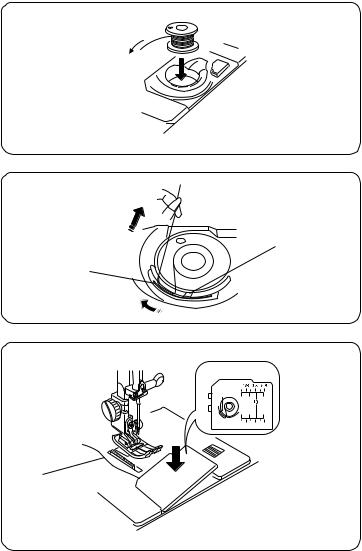
• Inserting the Bobbin
z
z Place the bobbin in the bobbin holder with the thread running counterclockwise.
x |
x Guide the thread into notch A on the front side of the |
|
bobbin holder. |
||
|
||
|
Draw the thread to the left, sliding it between the |
|
A |
tension spring blade. |
|
B |
Continue to draw the thread lightly until the thread |
|
slips into notch B. |
||
|
Pull out about 15 cm (6") of thread. |
|
c |
c Attach the hook cover plate. |
|
Check the threading by referring to the chart shown on |
||
|
||
|
the hook cover plate. |
|
|
q Bobbin thread |
q
8
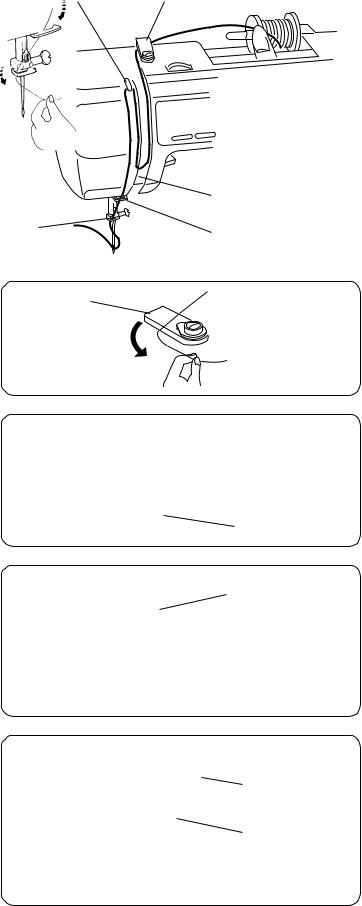
t |
e |
Threading the Machine |
u
z e
x
c
v b
• Threading the Machine
|
|
q |
* |
Raise the presser foot lifter. |
|
|
|
* |
Press the up/down needle position key twice to |
||
|
|
||||
|
|
|
w |
|
raise the needle. |
|
|
|
q Up/down needle position key |
||
|
r |
||||
|
w Presser foot lifter |
||||
y
z Draw the thread around the upper thread guide. e Upper thread guide
xThen, down around the check spring holder. r Check spring holder
r
|
c Firmly draw the thread from right to left over the |
t |
take-up lever and down into the take-up lever eye. |
|
t Thread take-up lever |
|
v Then, down through the lower thread guide. |
|
y Lower thread guide |
y |
b Slide the thread behind the needle bar thread guide on |
|
|
u |
the left. |
Thread the needle from front to back or use the needle |
|
|
threader. |
|
u Needle bar thread guide |
9

|
• Needle Threader |
|
z |
z Raise the needle to its highest position. Pull down the |
|
needle threader knob as far as it will go. |
||
|
x |
x Turn the knob in the direction of the arrow in the |
|
illustration, then insert Hook q into the needle eye. |
|
Lead the thread around Guide w and under Hook q. |
|
q Hook |
|
w Guide |
wq
c v |
c Turn the knob in the direction of the arrow in the |
|
illustration, drawing the thread loop through the |
|
needle. |
|
v Pull the thread through the needle eye. |
|
The needle threader can be used with a #11 to #16 |
|
needle or a blue tipped needle. Thread size 50 to 100 |
|
should also work well. |
10

|
• Drawing Up the Bobbin Thread |
¡ |
¡ Raise the presser foot. Hold the needle thread lightly |
|
with your left hand. |
™ |
™ Press the up/down needle position key twice to pick up |
|
the bobbin thread. Draw up the needle thread together |
|
with a loop of bobbin thread. |
|
q Up/down needle position key |
q
£ |
£ Pull 10 cm (4" ) of both threads to the back under the |
|
presser foot. |
11
